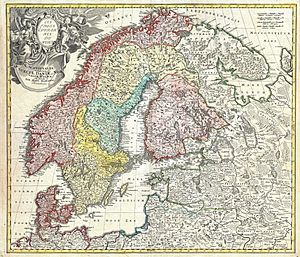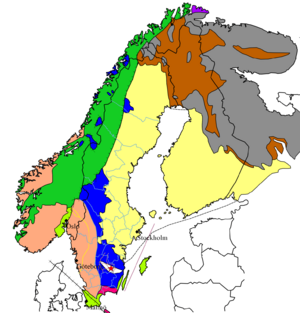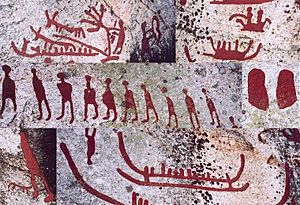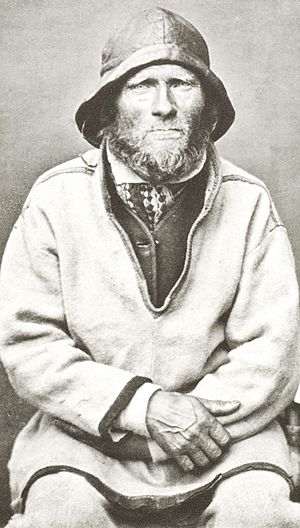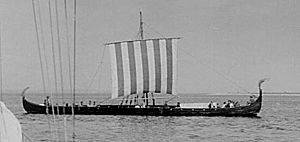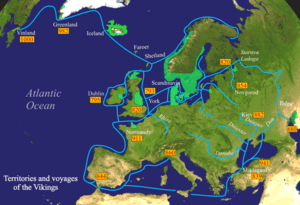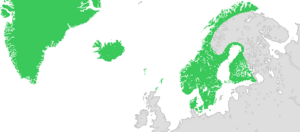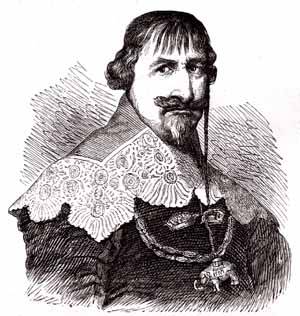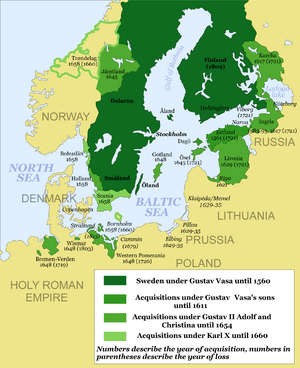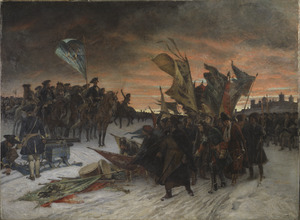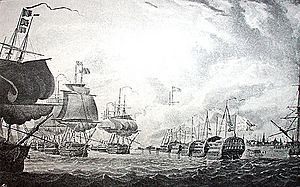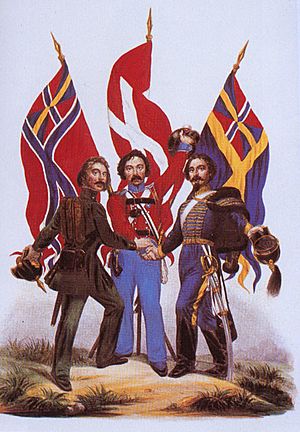History of Scandinavia facts for kids
The history of Scandinavia tells the story of the countries in Northern Europe: Denmark, Norway, and Sweden. Sometimes, Finland and Iceland are also included when people talk about Scandinavia. This region has a long and interesting past, from ancient times to today.
Contents
Not much is left from Scandinavia's very early history, like the Stone Age, Bronze Age, or Iron Age. We mostly find old tools made of stone, bronze, or iron. There are also some pieces of jewelry, ornaments, and stone burial mounds. A very important discovery is the many stone drawings, called petroglyphs, found across the region.
The Stone Age: When Ice Covered the Land
During the last Ice Age, called the Weichselian glaciation, most of Scandinavia was covered in thick ice. This meant the Stone Age started later here than in other parts of Europe. As the climate slowly got warmer and the ice melted, nomadic hunters from central Europe visited the area. People started living here permanently, though they still moved around, by about 12,000 BCE.
Upper Paleolithic: Reindeer Hunters
As the ice disappeared, reindeer grazed on the flat lands of Denmark and southern Sweden. People from the Ahrensburg culture hunted these reindeer. They lived in lavvus (tent-like homes) on the open plains. There were few trees, but slowly, thick forests began to grow.
Mesolithic: Forest Dwellers
From about 9,000 to 6,000 years ago, mobile groups lived in Scandinavia. They survived by hunting, fishing, and gathering food. About 200 burial sites from this period have been found.
Around 7,000 BC, forests covered southern Scandinavia. The Maglemosian culture lived in Denmark and southern Sweden. Further north, in Norway and most of southern Sweden, lived the Fosna-Hensbacka culture. These northern hunters followed animal herds and salmon, moving south in winter and north in summer.
By 6,000 BC, southern Scandinavia had thick forests with animals like aurochs (ancient cattle), wisent (European bison), moose, and red deer. The Kongemose culture hunted seals and fished. Later, the Ertebølle culture took over in the south.
Neolithic: Farmers Arrive
Around 5,000 BC, the Ertebølle people learned to make pottery from their neighbors. They also started farming and raising animals. By 3,000 BC, they became part of the Funnelbeaker culture, known for their large stone monuments called megaliths. These farmers spread into Sweden.
Later, new tribes arrived around 3,000 BC. Many scholars believe these people spoke an early form of the language that became modern Scandinavian languages. They were cattle herders, and with them, southern Scandinavia fully entered the Neolithic Age. This period also saw the start of working with metals.
Nordic Bronze Age: A Time of Trade and Art
Scandinavians started using bronze later than other parts of Europe, getting it through trade. But their Bronze Age sites are full of amazing objects made of wool, wood, and imported bronze and gold. This period saw the first advanced civilization in the area after the Stone Age.
Scandinavians adopted many symbols from central Europe and the Mediterranean Sea. This influence likely came from trading amber (fossilized tree resin), which was found in Mycenaean graves (from ancient Greece). Many rock carvings show ships, suggesting that sailing was very important.
The Nordic Bronze Age had a warm climate, allowing many people to live there. But it ended with a big climate change, becoming colder and wetter. This change might have pushed Germanic tribes south into Europe.
Pre-Roman Iron Age: Germanic Tribes Emerge
The Nordic Bronze Age ended with a colder, wetter climate. This time period has fewer archaeological finds. This is also when Germanic tribes became known to the Roman world. Around 113–101 BC, two Germanic tribes from modern-day Denmark, the Cimbri and the Teutons, attacked the Roman Republic. They caused big losses for Rome before being defeated.
At first, iron was very valuable and used for decorations like needles. Swords and sickles were also made. Bronze was still used, mostly for ornaments. People continued traditions from the Bronze Age, but there were strong influences from Central Europe.
Roman Iron Age: Roman Connections
Even though many Germanic tribes had contact with the Roman Empire, much of Scandinavia was far from the Roman world. Roman writers rarely mentioned Scandinavia.
However, many Roman goods were imported into Scandinavia. These included coins (over 7,000!), vessels, bronze images, glass cups, and weapons. The style of metal objects and clay pots also became very Roman.
Many bog bodies (well-preserved bodies found in peat bogs) from this time have been found in Denmark and southern Sweden. Along with the bodies, weapons, household items, and wool clothes were found. Large rowing ships from the 4th century have also been discovered.
During the 5th and 6th centuries, gold and silver became more common. This was likely due to Germanic tribes taking riches from the Roman Empire, and many Scandinavians returning with gold and silver.
Germanic Iron Age: Golden Art and New Peoples
After the Roman Empire fell, the period is called the Germanic Iron Age. It's divided into early and late parts. In Sweden, the late part is known as the Vendel Age, with rich burials. The early Germanic Iron Age is when the Danes first appear in history.
During the fall of Rome, a lot of gold came into Scandinavia. Beautiful gold items were made, like scabbard decorations and bracteates (thin gold discs). Famous examples are the Golden horns of Gallehus.
After the Roman Empire was gone, gold became scarce. Scandinavians started making objects from gilded bronze (bronze covered in a thin layer of gold). These items had decorations of animals with twisting, interwoven limbs, a style that became famous in the Viking Age.
In 2020, researchers found a 1,500-year-old Viking arrowhead in a melting glacier in Norway. It dates back to the Germanic Iron Age.
The Sami People
The Sami people have lived and worked in the northern parts of Norway, Sweden, Finland, and Russia for at least 5,000 years. They are one of the Arctic peoples.
The Sami have a long history with the Scandinavians (also called Norse people). While the Sami have lived in Fennoscandia for a very long time, their settlement in northern Scandinavia didn't happen before the Norse people settled in the south.
Ancient rock carvings and settlements from about 10,000 BC are found in Sami lands. These early hunters and gatherers are called Komsa by researchers. Since 1990, the Sami in Norway have been recognized as an indigenous people, giving them special protection and rights under international law.
The Viking Age: Explorers and Warriors
The Viking Age was a time when Vikings (Scandinavian warriors and traders) explored, raided, and settled in many parts of Europe, the Middle East, and even as far as Newfoundland in North America.
The Viking Age usually starts in 793 AD, when Vikings attacked the monastery of Lindisfarne in Britain. It ends in 1066, after the unsuccessful invasion of England by Harald Hårdråde.
Age of Settlement: Vikings Spread Out
The age of settlement began around 800 AD. Vikings invaded and settled in places like Scotland, England, Greenland, the Faroe Islands, Iceland, Ireland, Normandy, and even Vinland (in North America).
Swedish settlers mostly went east to places like Rus' (modern-day Russia) and Livonia. Norwegians and Danes focused on western and northern Europe. The eastern travelers were called Varangians. They are believed to have founded Kievan Rus, an important early East European state. Western Vikings left a big mark on places like French Normandy, England, and Ireland. The city of Dublin was founded by Viking invaders. Iceland was first settled in the late 9th century.
Vikings and Slavs
During this time, Norsemen mixed a lot with the Slavs (people from Eastern Europe). Their cultures influenced each other. Many goods were traded from Slavic areas to Scandinavia. Denmark, in particular, was a "melting pot" of Slavic and Scandinavian people.
For example, a 10th-century grave in Denmark, thought to be a Viking warrior-woman, was found to belong to a Slav from Poland. Early Swedish kings also had connections with Polish royalty.
Christianization: New Beliefs Arrive
Viking beliefs were strongly linked to Norse mythology. Vikings valued battle and honor, and believed in Valhalla, a mythical home for fallen warriors.
Christianity came to Scandinavia later than in most of Europe. In Denmark, Harald Bluetooth made the country Christian around 965 AD. In Norway, the process began under kings Olaf Tryggvason (995-1000 AD) and Olaf II Haraldsson (1015-1030 AD). English missionaries helped convert Norway. As Christianity spread, old shamanistic practices were stopped and sometimes punished.
Iceland became Christian in 1000 AD, partly due to pressure from Norway. A chieftain named Þorgeirr Ljósvetningagoði helped by making Christianity the official religion. But he also allowed private practice of old beliefs, which helped avoid civil war.
Sweden took longer to become Christian. Old religious practices were common in local communities until the late 11th century. A brief civil war in 1066 showed the conflict between old beliefs and Christianity. By the mid-12th century, Christianity had won. The adoption of Christianity helped Viking communities join the wider European culture.
The Middle Ages (1100–1600)
The Kalmar Union: Three Kingdoms United
The Kalmar Union was a series of agreements from 1397 to 1520. It united the three kingdoms of Denmark, Norway, and Sweden under one ruler. The countries kept their independence but shared a monarch. However, different interests, especially Sweden's unhappiness with Danish rule, led to conflicts. The Union finally broke apart in 1523.
The Kalmar War (1611–1613) was the last attempt by a Danish King, Christian IV, to forcefully bring back the Kalmar Union. Denmark won a small victory, but the Union was never reformed.
The Reformation: A New Religion
The Protestant Reformation arrived in Scandinavia in the 1530s. Scandinavia quickly became a center for Lutheranism. Catholicism almost completely disappeared in Scandinavia, except for a small group in Denmark.
The 17th Century
The Thirty Years' War (1618-1648) was a big conflict in Central Europe. It started as a religious war between Protestants and Catholics. Denmark and Sweden joined the war at different times to protect their interests.
Denmark joined first in 1625. King Christian IV, a Lutheran, led an army against the Holy Roman Empire. He feared that Denmark's independence was at risk. Christian IV had done well for his kingdom, gaining wealth and stability. But his army was badly defeated, which was a big setback for Denmark.
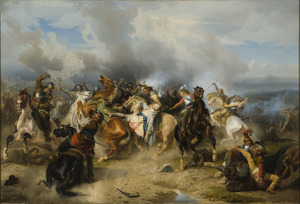
Sweden joined the war in 1630. King Gustavus Adolphus wanted to help the German Lutherans and gain economic power around the Baltic Sea. Like Christian IV, he received money from France and the Dutch. From 1630 to 1634, Swedish forces pushed back the Catholic armies and took back many Protestant lands.
Rise of Sweden: A New Empire
Sweden became a powerful country under King Charles IX. Through wars with Poland, Denmark-Norway, and German states, Sweden expanded its territories. There were some losses, like in the Kalmar War, but Sweden continued to build its empire. More wars followed, including the Northern Wars and the Scanian War. Denmark suffered many defeats during this time. Finally, under King Charles XI, Sweden became a strong, centralized monarchy.
The 18th Century
Great Northern War: Russia Becomes a Power
The Great Northern War (1700-1721) was fought between Sweden and a group of countries including Russia, Denmark-Norway, and Poland. The war started with an attack on Sweden in 1700. It ended in 1721 with peace treaties. As a result, Russia took Sweden's place as the main power on the Baltic Sea. Russia also became a major player in European politics.
Both Sweden and Denmark-Norway had colonies outside Scandinavia from the 17th to the 20th century. Greenland, Iceland, and the Faroe Islands in the North Atlantic were Norwegian lands that became part of Denmark-Norway.
In the Caribbean, Denmark started colonies on islands like St Thomas (1671) and St John (1718). They also bought Saint Croix from France in 1733. Denmark had colonies in India, like Tranquebar.
Sweden also had a short-lived colony called New Sweden in Delaware, North America, in the 1630s. Later, Sweden gained Caribbean islands like Saint-Barthélemy (1785–1878) and Guadeloupe. Both Danish and Swedish trading companies, like the East India Companies, were very active.
The 19th Century
Napoleonic Wars: Divided Loyalties
Scandinavia was divided during the Napoleonic Wars. Denmark-Norway tried to stay neutral. But after Britain demanded their navy, Britain attacked the Danish fleet in the Battle of Copenhagen (1801) and bombarded the city in 1807. Most of the Danish fleet was captured. This led Denmark-Norway to ally with France and go to war with Britain. The British navy blocked Denmark-Norway, causing food shortages in Norway.
Sweden, allied with Britain, tried to invade Norway in 1807 but was pushed back. After the war, Denmark had to give Heligoland to Britain.
Sweden joined the fight against Napoleon in 1805. But after Russia allied with France in 1807, Russia invaded Finland in 1808. Sweden had to give Finland to Russia in 1809. The Swedish king, Gustav IV Adolf, was removed from power. A new constitution was created, and his uncle, Charles XIII, became king. Since he had no children, Sweden chose a French general, Jean-Baptiste Bernadotte, to be the next king.
In 1813, Sweden joined the alliance against France and was promised Norway as a reward. After a battle in 1813, Bernadotte marched against Denmark. He forced Denmark-Norway to sign the Treaty of Kiel in 1814. Norway was given to the King of Sweden. However, Norway declared its independence, wrote its own constitution, and elected Prince Christian Frederik as king. After a short war with Sweden, Norway agreed to a personal union with Sweden. The Norwegian parliament elected the Swedish king as King of Norway.
Sweden and Norway: A Union Forms and Ends
On January 14, 1814, the King of Denmark-Norway gave Norway to the King of Sweden in the Treaty of Kiel. Norwegians strongly opposed this. The Norwegian prince, Christian Frederik, led an uprising. He became regent and called a meeting to write a constitution. On May 17, 1814, the Constitution of Norway was signed, and Christian Frederik was elected king of independent Norway.
The Swedish king rejected Norway's independence and launched a military campaign in July 1814. The Swedish army was larger and better trained. After short battles, an agreement was reached. Christian Frederik agreed to give up his claim to the Norwegian crown. In return, Sweden accepted Norway's democratic constitution and a loose personal union. On November 4, 1814, the Norwegian Parliament changed its constitution to allow the union with Sweden. They elected the Swedish king as King of Norway.
Over time, Norwegians became unhappy with the union. On June 7, 1905, the Norwegian parliament declared the union dissolved. Sweden threatened war, but negotiations led to an agreement. Both parliaments ended the union, and King Oscar II of Sweden recognized Norway as an independent kingdom. The Norwegian parliament offered the throne to Prince Carl of Denmark, who became King Haakon VII.
Finnish War: Finland Joins Russia
The Finnish War was fought between Sweden and Russia from 1808 to 1809. As a result, Finland, which was part of Sweden, became an independent Grand Duchy within the Russian Empire. Finland remained part of Russia until 1917, when it became fully independent. This war also led to Sweden adopting a new constitution and a new royal family, the House of Bernadotte.
Industrialization: New Ways of Working
Industrialization began in Scandinavia in the mid-19th century. In Denmark, it started in Copenhagen and then spread to smaller towns. Denmark remained mostly agricultural for a long time, but farming methods became modern.
Industrialization in Sweden grew quickly during World War I. Building railways to connect southern Sweden with northern mines was very important.
The idea of "Scandinavia" as a region became popular in the mid-19th century. This was due to the Scandinavist political movement. It was active between the First war of Schleswig (1848–1850), where Sweden and Norway helped Denmark, and the Second war of Schleswig (1864), when Sweden did not provide military support.
Emigration: Seeking New Homes
Many Scandinavians moved to Canada, the United States, Australia, Africa, and New Zealand in the late 19th century. The main wave of emigration happened from the 1860s to the 1880s, but it continued until the 1930s. Most emigrants left rural areas looking for better farming and job opportunities.
Almost a third of the population from Scandinavia, Finland, and Iceland left in the 80 years after 1850. This was partly because the population grew quickly, leading to more unemployment. Norway had the highest percentage of emigrants, and Denmark the least.
Between 1820 and 1920, over two million Scandinavians settled in the United States. About one million came from Sweden, 300,000 from Denmark, and 730,000 from Norway. The number for Norway was almost 80% of its population in 1800! Popular places in North America were Minnesota, Iowa, the Dakotas, Wisconsin, Michigan, and the Canadian prairies.
The Scandinavian Monetary Union was formed by Sweden and Denmark on May 5, 1873. They fixed their currencies to the gold standard at the same value. Norway joined two years later in 1875. This union was one of the few real results of the 19th-century Scandinavian political movement.
The union provided stable exchange rates. Even though it wasn't planned, people trusted the currencies so much that they were accepted almost everywhere in the region. The union ended when World War I started in 1914. Sweden stopped linking its money to gold, and the free circulation of currencies ended.
The 20th Century
First World War: Staying Neutral
All three Scandinavian countries remained neutral during the First World War. The war still affected their economies, mainly because Britain blocked trade with Germany. However, they made trade agreements with Britain. Norway's large merchant ships delivered important supplies to Britain but suffered many losses from German attacks. Denmark called up much of its military, but Germany still violated Danish territory. Many ethnic Danes from southern Jutland fought in the German army.
Welfare State: Helping Citizens
All three countries developed social welfare states in the early to mid-20th century. This happened partly because social-democratic parties in Sweden and Denmark, and the Labour party in Norway, became very strong. These systems aim to provide social and economic support for all citizens.
Second World War: Invasion and Resistance
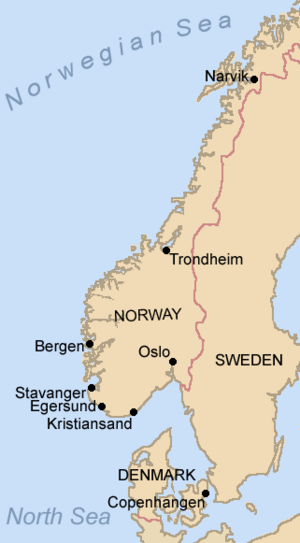
Near the start of World War II in late 1939, both the Allies and the Axis Powers worried about their enemies gaining power in Scandinavia. Germany wanted Swedish iron ore, which came through Norway. They also wanted Norway's ice-free ports. So, Germany invaded both Denmark and Norway on April 9, 1940.
The countries reacted differently. Denmark surrendered in two hours, losing only 16 men. They hoped to avoid civilian deaths and get better treatment from Germany. Norway, however, refused to give up and fought bravely with its limited forces. The Western Allies sent help, but it wasn't enough. By June 10, 1940, Norway's military had surrendered, and King Haakon VII and his government fled to Britain.
Denmark's strategy worked better in the short term. Germany gave Danes a lot of freedom. Danes were also seen as fellow Nordics by the Nazis. So, Denmark kept its parliament, king, and much of its normal life. But anger towards Germany grew, and small acts of sabotage became common. Germany eventually reacted by ending Denmark's government and imposing strict rules.
Norway was treated much more harshly. Opposition parties were banned, and a Norwegian fascist party was put in charge. Vidkun Quisling was made Minister-President, controlled by Berlin. These harsh rules meant there was little cooperation. About 10% of Norwegians supported the Nazi party, but most had a hostile relationship with the German occupation force.
Denmark and Norway also differed in how they dealt with Germany's persecution of Jews. Norwegian police, controlled by Quisling's government, helped capture Norwegian Jews in 1942. However, brave Norwegians saved over half of the Jewish population by helping them escape to Sweden. Danish Jews avoided German persecution until 1943. Danes made great efforts to protect them. More than 96% of the Jewish population was taken by boat to safety in Sweden, while others hid with Christian Danish families.
Sweden was the only Scandinavian country not invaded. It remained neutral during the war. Sweden tried to keep peace with Germany by supplying them with raw materials. The Swedish government was careful not to anger the Nazis, even censoring newspapers and letting Nazis move supplies through Sweden to Norway until 1943. However, Sweden did help the Allies sometimes. They gave asylum to Jews who escaped from Denmark and helped Finland during the Winter War.
Post-War: New Alliances
After the war, all Scandinavian countries agreed they needed a shared defense plan. They discussed forming a Scandinavian defence union. This union would have kept them separate countries but made them act as one in foreign policy. However, the Cold War tensions between the United States and the Soviet Union, and plans for NATO, overshadowed this idea. When it became clear that the Western alliance couldn't give Scandinavia weapons quickly, Norway left the talks. Denmark was still willing to ally with Sweden, but Sweden saw few benefits. Norway and Denmark then joined NATO. Sweden remained neutral after a big debate.
European Integration: Joining the EU
The Nordic countries created the Nordic Council in 1952 and the Nordic passport union in 1954.
After a vote in 1972, Denmark became the first Scandinavian country to join the European Economic Community (EEC) in 1973. The EEC later became the European Union (EU). Sweden joined the EU in 1995. Norway remains outside the European Union after votes in 1972 and 1994. However, Norway is part of the Schengen treaty (allowing free travel) and the European Economic Area (allowing free trade). None of the Scandinavian countries (except Finland) have joined the Euro currency, as voters in Denmark and Sweden rejected it.
See also
 In Spanish: Historia de Escandinavia para niños
In Spanish: Historia de Escandinavia para niños


